Fast Growing Trees For Texas (With Pictures) – Identification Guide
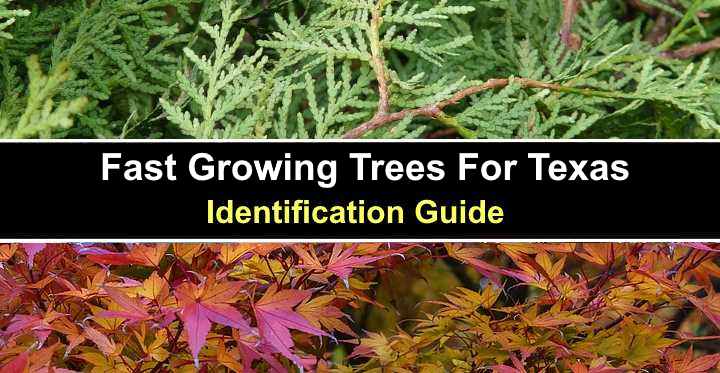
Fast-growing trees for a Texas landscape are perfect for quickly adding height, color, privacy, and shade to your garden. Texas trees with rapid growth typically grow several feet a year until they reach their mature height. And many varieties of trees thrive in the hot, humid, and sometimes dry climates of the Lone Star State.
Native Texas trees that grow fast help ensure they perform well in all regions of the state. Native trees are adapted to the unique conditions Texas offers. And they won’t become invasive or start competing with native plants, shrubs, and ornamental trees for nutrients or space.
The fastest-growing trees in Texas are the Texas ash (Fraxinus texensis), desert willow (Chilopsis linearis), and the American elm (Ulmus Americana). However, there are many other varieties of trees for planting in Texas that grow several feet a year.
This article describes the identifying features of many fast-growing trees suitable for Texas landscapes. Descriptions and pictures of deciduous and evergreen trees with rapid growth will help you decide about the best ones to plant in your front or backyard.
What Are Fast-Growing Trees for Texas?
Fast-growing trees typically have a growth rate of between 2 and 4 ft. (0.6 – 1.2 m) per year. This rapid annual growth means that the trees quickly reach their mature height, sometimes in ten years or less. However, some Texas trees have rapid growth when immature, but their growth rate slows down after a few years.
How to Choose Fast-Growing Trees for Texas
Choosing the best rapidly-growing native Texas trees to plant involves four factors. First, consider sun exposure and soil type to ensure the tree thrives in your garden landscape. Second, think about its mature height and spread to prevent it from encroaching on buildings and powerlines. Lastly, choose a fast-growing tree for your growing zone.
USDA growing zones in Texas range from 6 to 9.
The Panhandle north of Amarillo is zone 6.
North Texas along the border with Oklahoma is Zone 7 and includes the areas north of Dallas, San Angelo, and Midland.
Zone 8 is Central Texas, including the regions south of Dallas-Fort Worth to Austin and San Antonio.
Texas zone 9 is the lower tip of the state and the coastal area along the Gulf of Mexico.
Therefore, before choosing a tree that grows quickly, check your area’s growing zone before planting the tree.
Fast Growing Trees For Texas (With Pictures)
Fast-growing trees for Texas landscapes come in a variety of shapes and sizes. Some native deciduous trees are tall shade trees, whereas many small ornamental trees for Texas bloom with colorful spring and summer flowers
Here are some of the most popular evergreen and deciduous trees that grow quickly and thrive in the Lone Star State.
Red Maple (Acer rubrum)
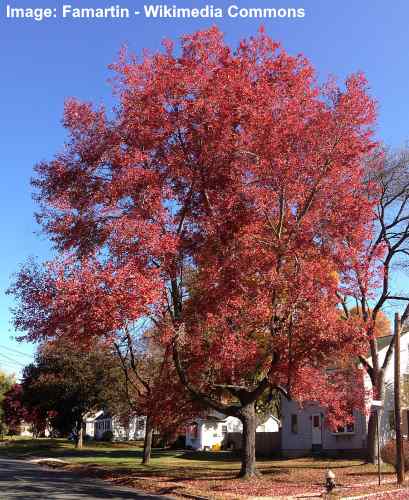
The fast growing red maple tree has a spectacular autumn foliage and looks great in any landscaped garden
The red maple tree is a beautiful, fast-growing shade tree for Texas landscapes. Growing around 3 ft. (1 m) annually, the maple tree has an attractive pyramidal habit, characteristic lobed leaves, and smooth gray bark. However, the outstanding ornamental feature of red maples is their spectacular red and yellow fall colors.
Red maples typically grow 40 to 70 ft. (12 – 21 m) tall and up to 50 ft. (15 m) wide. The native Texas deciduous tree thrives throughout the state, from Amarillo in the north to Galveston Bay in the south. It is an excellent choice as a shade or lawn tree.
Please check out the list of Texas shade plants to find shrubs that grow in the shadows of tall landscaping trees.
American Elm (Ulmus americana)
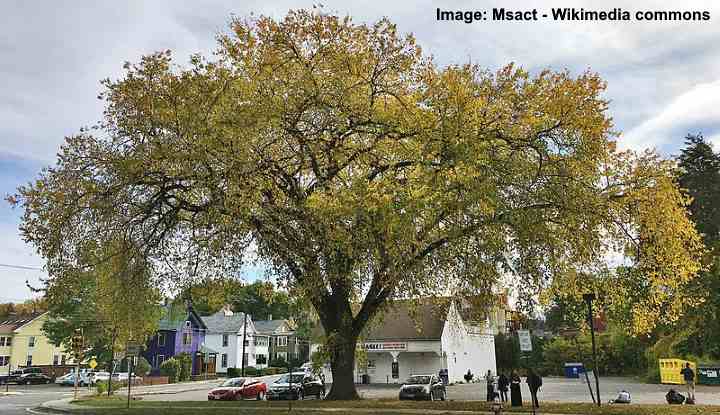
The large American elm tree grows fast and is hardy and tolerant of many conditions
The American elm tree is a fast-growing deciduous tree native to Texas. This elm variety increases in height at a rate of 2 ft. (0.6 m) per year. Its height, dense foliage, and upward-spreading canopy make it an ideal shade tree choice in Texas and other parts of the south.
Ornamental features of the impressive American elm are its leathery, dark green foliage that turns golden yellow in the fall. The leaves measure 3″ to 6″ (7 – 15 cm). American elms grow 60 to 80 ft. (18 – 24 m) tall and 40 to 70 ft. (12 – 21 m) wide. It is tolerant of drought, sea spray, and alkaline soils.
Suitable for USDA zones 2 to 9.
Desert Willow (Chilopsis linearis)
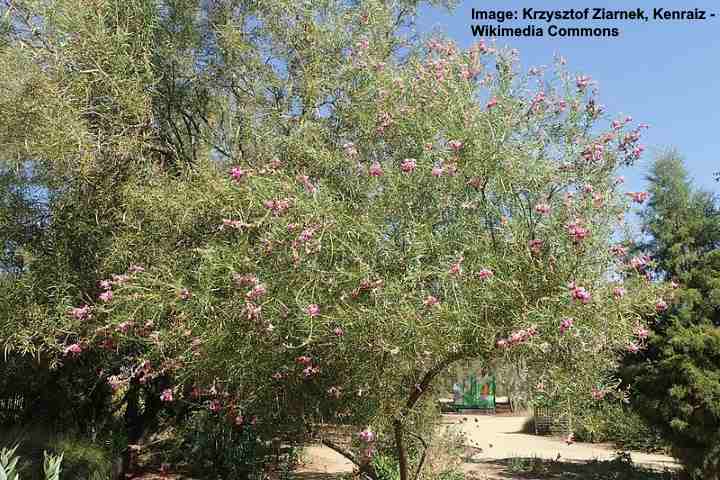
Desert willow is a pink flowering tree native to Western Texas that grows rapidly. In this picture: Chilopsis linearis ‘Timeless Beauty’
Desert willow is an attractive fast growing flowering tree for Texas landscapes that adds 3 ft. (1 m) in height annually. The identifying features of the willow-like tree are its clusters of showy funnel-shaped pink flowers, pointed bluish-green linear leaves, bean-like seed pods, and rounded habit.
The small ornamental desert tree grows 15 to 30 ft. (4.5 – 9 m) tall and 10 to 20 ft. (3 – 6 m) wide. Suitable for USDA zones 7 to 11, the tree thrives in all areas of the Lone Star State south of the Panhandle. As a desert plant, it thrives in dry, sandy soils and tolerates drought exceptionally well.
Texas Ash (Fraxinus texensis)

The Texas ash is a fast growing deciduous tree native to Texas and tolerant of dry environments
The Texas ash tree is one of the fastest-growing native Texas trees. This species of ash has pinnate leaves consisting of small lanceolate leaflets that turn orange, red, and purple in the fall. The Texas ash has a short trunk and rounded crown of dense foliage, making it a great shade tree in southern states.
Its rapid growth rate makes the Texas ash ideal for quick landscape solutions. In addition, the long-lived tree is tolerant of salty air, drought, and poor soils. The medium-sized tree grows up to 32 ft. (10 m) and thrives in full sun. It adds 2.5 ft. (0.7 m) to its height every year.
Common Hackberry (Celtis occidentalis)
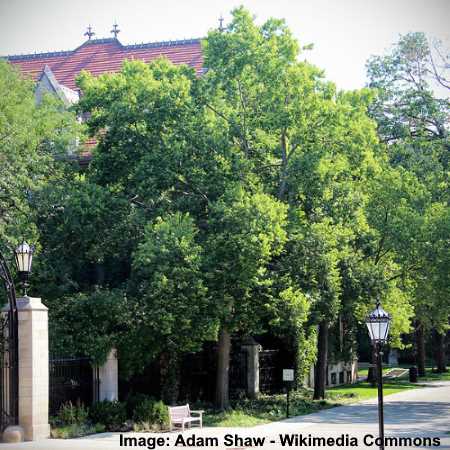
The common hackberry is a deciduous native Texas tree which is great as a shade tree
Native to Texas, the deciduous common hackberry tree is a large specimen plant, ideal for providing shade in hot southern summers. Identifying features of the hackberry tree are its ovate leaves with tapering apexes growing on arching branches. Additionally, the flowering tree produces clusters of greenish-yellow flowers followed by brown, olive-like fleshy, sweet edible berries.
Thriving from the Panhandle to the Mexican border and Gulf Coast, the common hackberry is a popular landscaping tree. It grows 40 to 60 ft. (12 – 18 m) tall and wide. The common hackberry tree grows well in sun, partial shade, and organically rich, well-drained, moist soil.
Shumard Oak (Quercus shumardii)
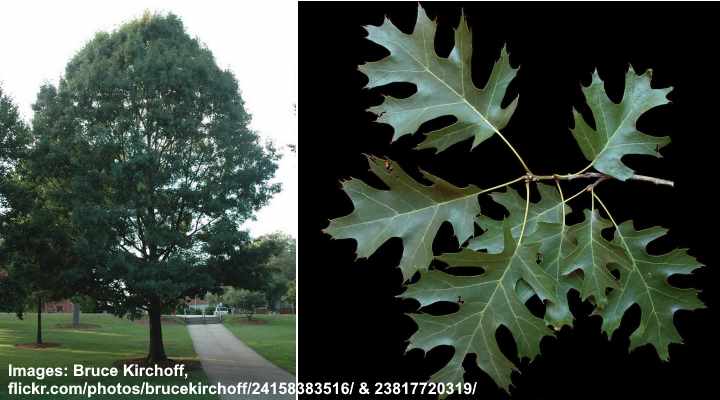
The Shumard oak tree is a fast growing beautiful shade tree that grows in eastern Texas
The Shumard oak tree is a contender for the title of fastest-growing tree in Texas. Also called the southern red oak, the deciduous oak tree boasts an expansive vase-like canopy, lush lime-green leaves with seven to nine pointed lobes, and spectacular bright red and bronze colors in the fall. In addition, this native Texas tree is drought-tolerant and withstands some flooding.
Shumard oak trees are easy to care for. Their spreading crown and densely growing foliage make it a stunning rapid-growth tree for Texas landscapes. Stretching at over 2 ft. (0.6 m) per year, the stately acorn tree matures at 40 to 60 ft. (12 – 18 m) tall and 30 to 40 ft. (9 – 12 m) wide.
Water Oak (Quercus nigra)
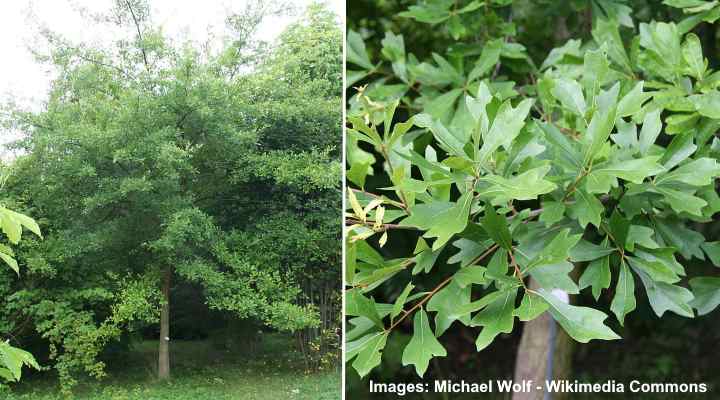
The water oak is a medium to large deciduous oak tree with a fast-growth habit that thrives in boggy soil
The water oak is a species of Texas oak tree that grows rapidly. Identifying features of the oak tree are its spatula-shaped leaves with three lobes at the tips, broad, round acorns in scaly caps, and grayish-black bark. The oak tree is also characterized by its rounded crown that provides shade in southern landscapes.
As its name suggests, the water oak tree thrives in marshy, boggy ground and is common in swamps in Texas. Suitable for zones 6 to 9, the water oak thrives throughout the state, growing in full sun. Water oaks grow 50 to 80 ft. (15 – 24 m) tall and 40 to 60 ft. (12 – 18 m) wide.
Eastern Redbud (Cercis canadensis)
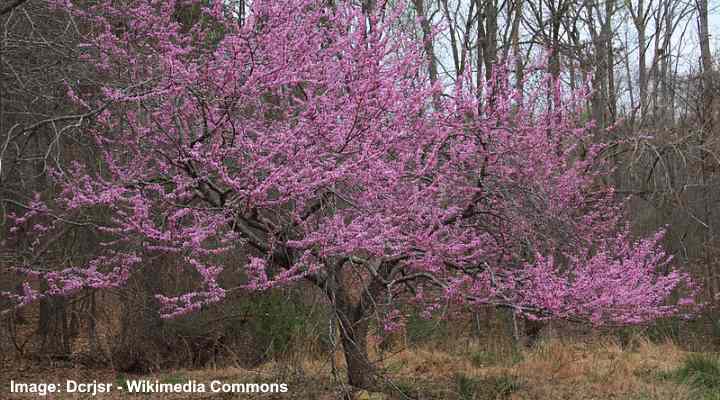
The eastern redbud tree grows quickly to become a relatively small tree with attractive pink flowers
The eastern redbud is one of the fastest-growing species of these small ornamental flowering trees for a Texan landscape. The eye-catching feature of redbud trees is their masses of showy pea-like pink flower clusters appearing in early spring. Redbud tree heart-shaped leaves emerge after the flowers, and the delightful pink blossoms give way to long dangling brown seedpods in the fall.
The decorative eastern redbud tree grows 20 to 30 ft. (6 – 9 m) tall, and its rounded crown spreads 25 to 35 ft. (7.5 – 10.5 m) wide. The sun-loving, spring-flowering tree thrives in xeric, dry landscapes and withstands the heat of Southern Texas. Suitable for planting in USDA zones 4 to 9.
Cherry Laurel Tree (Prunus caroliniana)

Carolina cherry laurel is a small ornamental tree which is very versatile and relatively fast growing
The cherry laurel tree is a small bushy tree that can also grow as a dense shrub. The evergreen tree has a moderate to fast growth rate and is extremely versatile in a landscape. The shrub-like tree has glossy green lance-shaped leaves, showy white, five-petalled flowers, and small black drupes appearing in the fall.
As a fast grower, cherry laurel quickly grows between 8 and 10 ft. (2.4 – 3 m) tall and 8 ft. (2.4 m) wide. This versatile shrub or tree is ideal for planting in a Texas garden as a foundation planting, specimen plant, hedge, or small tree.
Related reading: The best shrubs for a Texas landscape.
River Birch (Betula nigra)
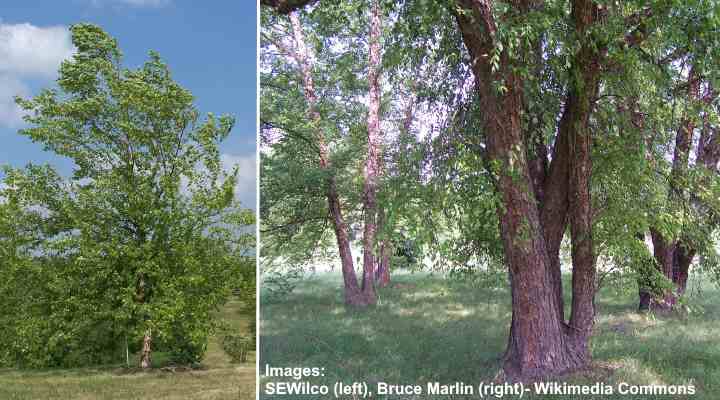
The river birch is a low maintenance tree with rapid growth rate and tolerance for wet soil
River birch is a multi-stemmed deciduous tree that thrives in wet soils throughout the Lone Star State. The eye-catching ornamental features of this birch species are its peeling bark that emerges pink and turns cinnamon-brown, diamond-shaped leaves, clusters of finger-like flowers, and drooping seed cones.
The river birch is ideal for landscaping a backyard in Texas as it’s the most heat-tolerant of the Betula trees. The mid-sized tree grows 40 to 70 ft. (12 – 21 m) tall and wide. You can plant the tree along ponds and streams.
Callery Pear (Pyrus calleryana)
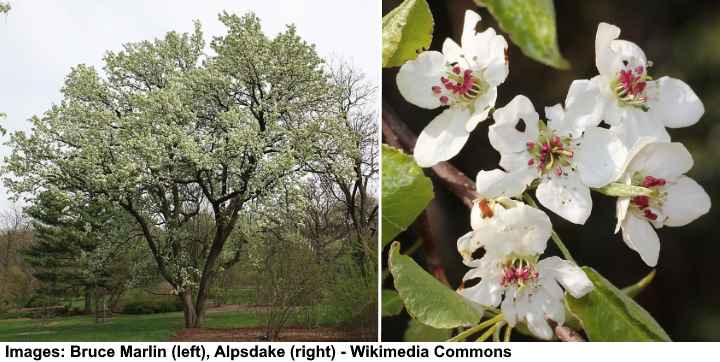
Callery pear is an ornamental flowering pear tree with spectacular white flowers every spring
The Callery pear is a fast-growing, ornamental tree native to Texas and famous for its showy white spring flowers. This small to medium sized decorative pear tree has five-petalled white flowers, leathery leaves with wrinkled margins, and clusters of yellowish-green fruits. In the fall, the deciduous tree turns shades of orange, red, and dark maroon.
This sun-loving, heat-tolerant tree thrives throughout all regions of Texas. It grows 30 to 50 ft. (9 – 15 m) tall and spreads up to 35 ft. (8 m) wide.
American Sycamore (Platanus occidentalis)
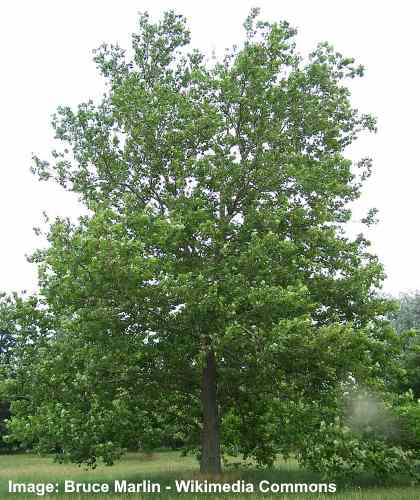
The large American sycamore tree grows fast and is often found along streams, rivers and wetland areas
American Sycamore is a towering native tree in Texas that has rapid growth. One of the outstanding features of this sycamore species is the camouflage-like bark that has shades of white, gray, and tan. In addition, the massive tree has a broad crown. It is adaptable to extreme weather conditions such as drought and heat.
Decorative features of the Texas shade tree are its maple-shaped leaves that turn yellow-brown in the fall, dangling spiky balls, and attractive exfoliating bark. The American sycamore grows 70 to 100 ft. (21 – 30 m) tall and wide in USDA zones 4 to 9.
The American sycamore is also on the list of fast-growing trees for Florida.
Flowering Dogwood Tree (Cornus florida)
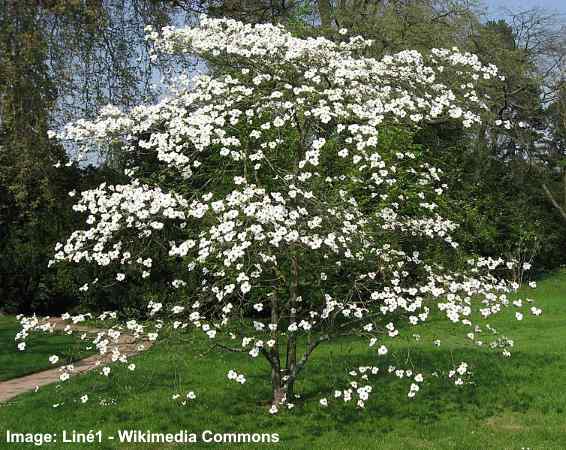
The fast growing dogwood tree is relatively small and has attractive white flowers
The flowering dogwood tree is a valuable and beautiful ornamental tree with a rapid growth rate, making it an excellent candidate for Texas landscapes. In addition, this decorative tree has a four-seasonal interest. The tree has large five-petalled white flower-like star-shaped bracts, dense foliage, vibrant red and purple fall colors, and interesting bark that looks like alligator skin.
Flowering dogwood trees thrive from the Panhandle and south to the Gulf Coast, east to El Paso, and west to Dallas. The small tree grows 15 to 30 ft. (4 – 9 m) tall and wide. Apart from growing as a specimen tree, dogwoods are ideal in lawns, shrub borders, or in patio containers.
Related reading: Dogwood trees with red berries.
Tuliptree (Liriodendron tulipifera)
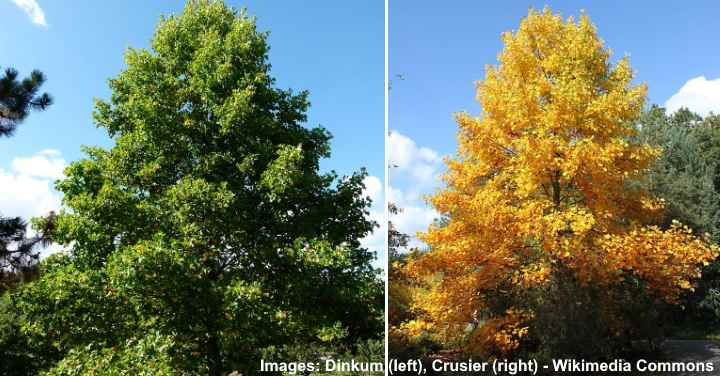
Tuliptrees – summer and autumn foliage
The tuliptree is a fast-growing, deciduous tree native to Texas. This tall, stately shade tree has an upright pyramidal shape with a broad crown. The tuliptree is known for its spring-blooming, showy yellow-green and orange flowers that resemble tulips. Additionally, the decorative tree has four-lobed leaves that turn golden yellow in the fall and cone-like fruit.
The tulip tree grows 60 to 80 ft. (18 – 24 m) tall and 30 to 40 ft. (9 – 12 m) wide. The most common landscape use of a tuliptree in Texas is as a specimen, lawn, or shade tree.
Leyland Cypress (Cupressus × leylandii)
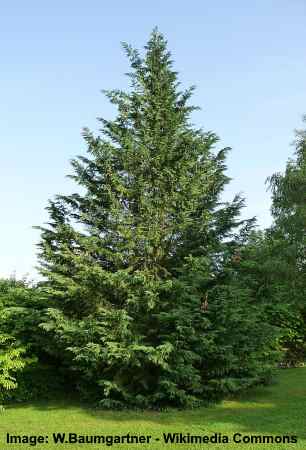
Leyland cypress is a fast growing evergreen tree which can be used for privacy screen
The Leyland cypress is a hybrid evergreen conifer with a rapid growth of around 2 ft. (0.6 m) per year. The impressive evergreen tree is known for its slender habit, bluish-green scale-like feathery sprays, small globular cones, and aromatic foliage. This pyramidal evergreen tree grows 60 to 70 ft. (18 – 21) tall and 15 to 25 ft. (4.5 – 7.6 m) wide.
The best landscaping uses for Leyland cypress are as a windbreak, evergreen hedge, or to create a boundary around homes. It’s suitable for growing in USDA zones 6 to 10, making an ideal evergreen tree for Texas.
Italian Cypress (Cupressus sempervirens)
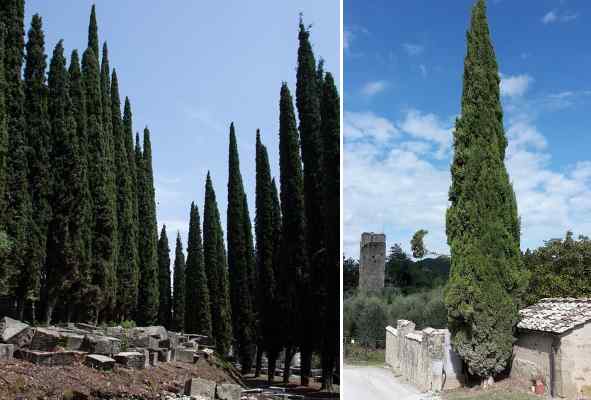
The tall narrow Italian cypress gives a stunning focal point in the landscape or it can be used as fast growing privacy screen when planted in a row
The Italian cypress is a fast-growing evergreen tree and is drought-tolerant in Central and Southern Texas. The skinny coniferous tree has bluish-green needle-like aromatic leaves, ovoid cones, and a columnar habit. This species is ideal for compact yards and urban gardens in warmer areas in the southern states.
The Italian cypress grows 40 to 70 ft. (12 – 21 m) tall and only 10 to 20 ft. (3 – 6 m) wide. The heat and drought-tolerant evergreen tree performs well in the humidity of the Southeast. It is an excellent specimen plant to add a vertical accent to an arid landscape.
Eastern Red Cedar (Juniperus virginiana)

The eastern red cedar is not a true cedar but a type of fast growing juniper tree
The eastern red cedar is a fast-growing and hardy native conifer in North America. The coniferous landscaping tree grows around 2 ft. (0.6 m) annually. Its dense scale-like foliage is dark green in the growing season but turns bronze in colder regions of Texas. This cedar species also has attractive reddish-brown bark. The female trees also produce pale bluish berry-like cones.
The eastern red cedar has a broadly pyramidal, mostly columnar habit. The native evergreen cedar grows 40 to 50 ft. (12 – 15 m). The low-maintenance conifer is perfect for growing as a hedge, large screen, or specimen plant in a Texas landscape.
Related articles:
